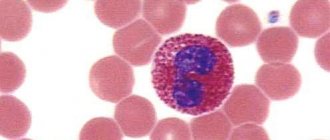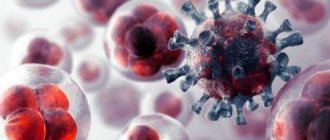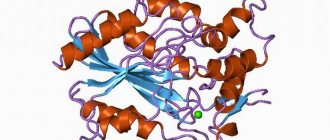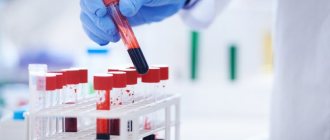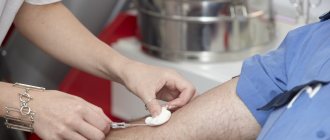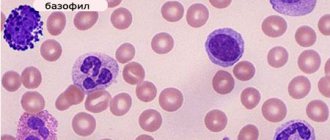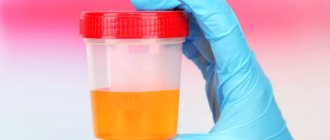0
Author of the article: Marina Dmitrievna
2017.09.23
2 380
Blood analysis
Blood sterility test is a clinical test aimed at identifying pathogenic bacteria in the blood. Allows you to diagnose serious diseases of various etiologies.
Attention! Correct diagnosis of bacterial infections allows you to prescribe effective drug therapy. In recent years, there has been a significant increase in the number of bacterial infections resistant to modern antibiotics. Scientists believe this is due to widespread misprescription of antibacterial drugs.
Known antibacterial drugs
Taking material
The goal is to place the patient's blood sample in a culture bottle in a manner that avoids any bacterial contamination (from the environment, from the hands of staff, or from the patient's skin).
Sample collection time
Blood cultures should be drawn before antibiotic treatment is started, as they may delay or prevent bacterial growth, causing a false negative result. In patients with intermittent fever, blood should be drawn when the temperature rises or immediately after the peak of the temperature, if possible. At this time, the number of bacteria in the blood is maximum.
Many laboratories recommend taking a second blood sample for bacteriological analysis no later than 1 hour after the first to increase the chances of detecting bacteria and distinguishing true bacteremia (bacteria will be present in both samples) from bacterial contamination.
Blood Culture Vessels
Blood for bacteriological analysis should be collected in special bottles with a nutrient medium. There are several varieties of them produced by industry. They all contain a liquid mixture of nutrients necessary for bacterial growth.
Most laboratories provide two types of culture bottles for blood culture. The first contains oxygen above the liquid medium, which is necessary for the growth of aerobic bacteria (which require oxygen). The second contains a mixture of gases without oxygen for the cultivation of anaerobic bacteria (which grow only in the absence of oxygen). The blood sample should be added to both bottles.
Required blood volume
A patient with bacteremia may have only one microbial cell in 1 ml of blood, so if there is not enough blood added to the culture bottle, a false negative result can be obtained.
Paradoxically, a false negative result can also be obtained when too much blood is added to the culture medium. This is due to the fact that blood continues to have a bactericidal effect in culture if it is not sufficiently diluted with a nutrient medium. A compromise must be made between too little blood volume, where there is not enough bacteria, and too much volume, which may reduce the effect of blood dilution by the culture medium. On average, dilution of blood during bacterial inoculation with nutrient medium in a ratio of 1:10 is optimal, but the required volume (usually 5-10 ml) depends on what nutrient medium is used
It is very important that each bottle contains at least as much blood as required by the local bacteriological laboratory
What can culture show?
The question of what tank sowing can show comes up quite often. What infections can a bacterial culture test detect in women? What does culture test for microflora show? We provide answers to these and other questions below.
Depending on the pathogen detected, there are:
- Culture for staphylococcus. A tank culture for staphylococcus is indicated during pregnancy and allows you to identify golden, epidermal, saprophytic and hemolytic staphylococci, which are dangerous for the pregnant woman and the fetus.
- Culture for chlamydia. It is indicated for doubtful, false-positive and false-negative test results for this disease. A tank culture for chlamydia gives a reliable result and allows you to correctly prescribe treatment.
- Tank culture for gonorrhea. It is indicated for persons with complaints about the main manifestations of the disease, if a partner is diagnosed with the disease, or with a probable risk of domestic infection. It remains informative not only before or after treatment, but also during therapy.
- Tank culture for tuberculosis. It is indicated for suspected respiratory tuberculosis. To obtain reliable results, it is necessary to examine at least three sputum samples.
- Bacterial culture for enterococci (can be found in the form: “in bacterial culture of enterococcus faecalis”). Allows you to identify opportunistic enterococci - representatives of the normal microflora of the human digestive tract, dangerous and pathogenic for the composition of the microflora of the genitourinary system.
- Tank sowing for whooping cough. Allows you to identify the disease and develop an optimal treatment program. It is indicated in the presence of a weak cough that persists for 1-2 weeks, a slight increase in temperature, or severe malaise.
- Tank culture for dysentery group. The analysis is indicated for diseases of the gastrointestinal tract accompanied by diarrhea. And also in case of hospitalization in a hospital, the presence of urethritis, vulvovaginitis, cervicitis, cystitis. Allows you to detect salmonellosis and dysentery in children and adults, and escherichiosis in children.
Indications for analysis
The study is prescribed in the following situations:
- With a prolonged increase in temperature within the range of 37 to 38℃ in the absence of other visible symptoms of disease.
- If you suspect HIV infection.
- In preparation for surgical treatment.
- For the prevention of sepsis in the postoperative period.
- In the presence of specific symptoms that do not disappear after a course of antibiotic treatment.
- If you have various types of implants in your body, such as artificial valves in the heart.
The analysis is often prescribed in the presence of chronic forms of pustular lesions, including chronic furunculosis and other types of pathologies accompanied by the formation of purulent infiltrates.
Decoding
Blood culture results are divided into the following three groups:
- no bacterial growth
- net growth
- mixed growth
No bacterial growth
Lack of bacterial growth is a normal blood culture result, which is obtained if the patient's blood is sterile
Before deciphering the result in this way, it is important to consider the possibility that it is a false negative, i.e.
The patient has bacteremia, but it was not detected by this test.
Reasons for a false negative result
- not enough blood added to culture medium
- antibiotic treatment was started before blood was drawn
- the incubation period is insufficient for the growth of rare slow-growing species
Net bacterial growth
Pure bacterial growth means that there is growth of a single species of bacteria (E. coli, S. aureus, S. pneumoniae, etc.) that was isolated from the culture. This bacteriological blood culture result should be expected if the patient has sepsis. However, in approximately 10-20% of cases, the isolated bacteria do not originate from the patient’s blood, but enter the nutrient medium due to violation of the rules of asepsis when taking a blood sample. Since all types of bacteria can cause septicemia, it is sometimes difficult to decide whether a clear growth is the result of bacterial contamination (false positive) or reflects the presence of septicemia (positive).
To demonstrate this explicitly, let's assume that S. epidermis is isolated from blood culture. This microorganism, which is normally present on the skin of each of us, could easily get into the culture medium from the patient’s skin or from the hands of staff during the process of drawing blood. Indeed, S. epidermis is the most common bacterial blood culture contaminant. At the same time, it is a common cause of septicemia in patients with an infected intravenous catheter. It also causes endocarditis in patients who have had heart surgery. Its detection may indicate contamination, but in some cases may be clinically significant.
It is bacteria such as S. epidermis, which are part of the normal human microflora, that most often contaminate blood cultures. Net growth of any microorganism in a blood culture is more likely to reflect the presence of septicemia than bacterial contamination if:
- the same microorganism was isolated from the patient and from some other source of infection;
- the same microorganism was isolated from a repeat blood sample.
Mixed growth—This result indicates that more than one species of bacteria was isolated from the blood culture. Infection of the blood with more than one type of bacteria is rare, although it can occur. Mixed growth of bacteria during bacteriological blood culture usually confirms contamination of the culture medium, especially if the isolated bacterial species are common contaminants. Interpreting blood culture results can be difficult and often requires the assistance of an expert microbiologist.
How to collect biological material
The quality of the study strongly depends on the correctness of the collected biomaterial. Therefore, there are strict rules for sampling, without which it is impossible to obtain correct information about a person’s health status.
- The material must be collected using sterile instruments and placed only in sterile containers. If this is ignored, collecting material and further research will become pointless.
- It is necessary to collect biomaterial strictly before starting antibiotic therapy. Otherwise, the laboratory assistant will identify false data. If the patient is currently undergoing antibacterial therapy, then bacteriological studies should be carried out only 10 days after the end of taking the last tablet.
- When collecting urine, you need to take only the middle portion in the morning. Urine must be placed in a sterile container. The amount of collected material should be 10-15 ml. In addition, you should definitely try to deliver the urine to the laboratory in less than 2 hours after collection.
- Before collecting mucus from the nose or throat, do not eat, drink, brush your teeth or rinse your mouth with disinfectants.
- Collecting stool should be done with a sterile spatula. Collection time is morning. The material must be placed in sterile containers. The amount of feces collected should be 15-30 grams. It takes less than 5 hours to get him to the hospital. You should not leave stool overnight or freeze it.
- Breast milk is expressed only after a hygienic procedure. To do this, the area of the nipples and breasts is thoroughly washed with water, then treated with a swab of ethyl alcohol with a strength of 70%. Next, express 15 ml of milk, which is not used for testing. The next 5 ml are expressed into a sterile container and sent to the laboratory. The material must be delivered within two hours.
- Blood for bacteriological examination is taken against the background of temperature. For children, its amount is 5 ml, for adults - 15 ml. Here we must not forget that sampling is not carried out during the period of taking antibiotics.
- It is necessary to collect sputum during a coughing attack. At this moment, mucus is released from the throat. The sputum is delivered to the laboratory within one hour.
- In women, the material is collected 14 days after menstruation; women should not urinate for 2 hours, and at least one month must pass after taking antibiotics. When collecting sperm from men, you should not urinate for approximately 5-6 hours before taking the test.
Technique for performing bacteriological blood culture
Aseptic technique must be followed to avoid bacterial contamination of the blood culture. If the sample is taken correctly, only the microorganism that is in the patient's blood will end up in the culture bottle.
Blood for bacteriological culture should be taken from a peripheral vein, but never use an indwelling catheter, which may be contaminated with bacteria. The bacterial culture procedure should be carried out wearing sterile gloves or cleanly washed hands. The venipuncture site must be lubricated with a 2% iodine solution or other suitable antiseptic. After 1-2 minutes, iodine should be removed with 70% alcohol and make sure that the skin is dry. The lid of the culture medium bottle into which the blood sample is added must also be disinfected. Blood is taken with a sterile syringe and needle, being careful not to touch the puncture site with your hands. The blood is added to the bottle with the culture medium through the rubber stopper that closes it. Never remove the cap from a bottle. This can lead to contamination by bacteria from the environment. If blood is taken at once for multiple tests, fill the bottle with culture medium first to prevent the introduction of foreign bacteria from other laboratory glassware. The blood culture must be labeled with the patient's information and sent to the laboratory without delay along with the accompanying card. If blood is drawn when laboratory work is completed, the bottles should be placed in an incubator at +37°C to allow bacterial growth to occur.
It is important to provide the accompanying card with basic clinical data and information about antibiotic therapy, if it was carried out before blood collection.
Blood test for sterility: how it is done and carried out
A blood sterility test is performed to find out about bacteremia. Doctors recommend doing it before the therapy process and directly on an empty stomach in order to determine whether there are symptoms of serious diseases in the body.
How is sterility testing done?
Blood, urine, and breast milk are normally sterile. But sometimes various bacteria and fungi can multiply in them. Particularly dangerous are the microorganisms streptococci, as well as their varieties: Staphylococcus aureus, yeast fungi and enterobacteria.
These types of microorganisms can significantly reduce human immunity. If immunity is reduced due to other diseases, they can completely destroy it.
It is necessary to donate blood immediately before the course of therapy so that they cannot be falsely negative. Such sterility indicators make it possible to identify serious diseases, including pyoderma, meningitis, and sepsis.
In order to determine the type of bacteria, a serious laboratory study is carried out. As a result of this indicator, about 20 types of bacteria are identified that can cause serious diseases in the future. If bacteria are already present in the body, using this indicator you can determine the amount of harm they have already caused and take medical measures to destroy them.
Blood culture for sterility is one of the most common tests for patients diagnosed with very serious diseases.
The diagnosis is made in specialized medical institutions in cases where it is impossible to establish the exact cause of the disease.
The usual human body temperature of 36.6 °C does not allow them to develop much, and they may simply die. By combining and concentrating in a certain human organ, they are able to increase body temperature to 39-40 ° C and maintain it for a long time.
In addition to this indicator, research is required for both meningitis and sepsis. By conducting a complete analysis, it is possible to diagnose not only those bacteria that lead to serious diseases, but also opportunistic bacteria that can provoke the development of cancer and tumors.
In addition, tests are carried out to help the specialist determine which types of antibiotics can be used in treatment and which cannot.
When is it necessary to conduct a sterility test?
Before you begin drawing blood from a venous artery, you need to do standard work. To do this, you need to give up alcohol and tobacco for 2 days. In addition, it is recommended to exclude fatty and spicy foods from the diet.
If at the time of the tests you are taking medications to maintain your vital functions, you cannot stop taking them on your own.
In this case, it is mandatory to consult a doctor, and only he can decide what amount of medication you are allowed to take at the time of the tests.
Blood from a healthy person shows 100% sterility. If pathogens are detected in the blood, this indicator can change dramatically. Bacteria can also enter the blood through pus if a person has ulcerative and inflammatory purulent processes.
To carry out the analysis, a blood sample of 5-10 ml is taken from a vein at the elbow. Next, it is placed in a bottle with a nutrient medium. All analyzes are carried out under conditions of absolute sterility in compliance with the required temperature conditions.
An important point is the fact that the earlier the blood is taken, the faster the likelihood is that the disease can be diagnosed in the early stages and treated in a timely manner.
Indicators are calculated in two stages. The preliminary result will be ready in 3 days. Based on it, you can determine what bacteria are present in the body. The final version with conclusions will have to be expected within 10 days.
Determination of microorganisms in these components allows you to find out whether there are pathogenic microbes in them. For a pregnant woman, testing breast milk for sterility is very important if she begins to breastfeed. A urine test for sterility will always help determine the presence or absence of stones and sand in the kidneys and the stage of their development.
Indications for use
The main indication for this type of analysis is the need to identify pathogenic microbes in the blood.
In a healthy state, the blood should be sterile and free of pathogenic bacteria.
The analysis is aimed at identifying streptococci, Pseudomonas aeruginosa, Staphylococcus aureus, yeasts and enterobacteria, which in a normal state the patient’s immunity itself would not allow to spread.
Photo:
But, for example, in the case of surgical interventions, protracted illnesses or when the body’s protective functions are weakened, these bacteria can multiply uncontrollably and cause significant harm to humans.
Therefore, for example, people with HIV need to undergo such examinations periodically for preventive purposes.
For example, it is not uncommon for people with immunodeficiency to become carriers of Mycobacterium tuberculosis, precisely because the body is unable to cope with external attacks on its own, while a person with an unimpaired immune system can cope well with such difficulties.
READ Why is uric acid in the blood low?
Some bacteria are difficult to diagnose and can only be detected through repeated studies (Staphylococcus epidermidis).
It is recommended to donate blood for testing before undergoing the prescribed course of therapy, so that the results of treatment are not distorted by the influence of pathogenic microorganisms.
Blood collection procedure
Venous blood donation is necessary to make a correct diagnosis. It contains the most reliable information about the state of the body. In young children, biomaterial is collected from the most accessible places. The fact is that the child has rather thin blood arteries and vessels.
Attention! Before taking the tests, you need to properly prepare for blood sampling. During the procedure, it is necessary to maintain complete sterility of the instruments and hands of the medical staff.
The puncture site is thoroughly treated with medical alcohol. Disposable syringes are used for sampling
During the procedure, it is necessary to maintain complete sterility of the instruments and hands of the medical staff. The puncture site is thoroughly treated with medical alcohol. For sampling, disposable syringes are used.
Next, I seal the test tube with its contents tightly and send it to the laboratory for detailed examination. Here the sensitivity of bacteria to antibiotics and antiviral drugs is tested.
Examination under a microscope
The presence of pathogenic microflora can only be detected using a special microscope. A similar procedure can be carried out either in a regular clinic or in a special laboratory.
Improperly performed blood sampling can cause infection with harmful bacteria. Taking this test multiple times helps to identify the main pathogen.
How to get tested?
In order to obtain the most reliable results of the study, it is necessary to donate blood correctly. To do this, a little preparation is made for its collection . It consists of a short fast (8 hours) and the need to adhere to a simple diet. Thus, it becomes clear that blood sampling is carried out most often in the morning. The diet involves eliminating alcohol three days before the test, as well as the need to reduce the fat content in the diet.
To test the sterility of blood, it is taken from a vein, but capillary blood can also be taken from young children for testing. Before puncture, the skin is treated and disinfected . Blood is taken using a special disposable syringe. For analysis, 10 ml of blood obtained from the ulnar vein is sufficient. Some patients are pre-administered an injection of adrenaline a third of an hour before the test. It helps to obtain more reliable data, since as a result of exposure to adrenaline, the human spleen begins to contract, and microorganisms, if they are in the blood, enter the bloodstream in large volumes.
After collection, the blood is placed in a special bottle with a nutrient medium , where the bacteria contained in it can quickly multiply. Such a bottle is subjected to research for 10 days. Initial results can be obtained after 3 days. They are called preliminary. Based on this study, data can be obtained about the type of bacteria that are already present in the body.
This study allows us to identify the sensitivity of the environment to the main types of antibiotics. But the final result can only be obtained 10–14 days after the test.
Expert opinion
Kovaleva Elena Anatolyevna
Doctor-Laboratory Assistant. 14 years of experience in clinical diagnostic services.
Ask a question to an expert
Based on its results, it is possible not only to obtain accurate data regarding the specifics of the disease, but also to determine the sensitivity of microorganisms to a wide range of drugs that can be used in treatment.
The sooner blood is taken to test for sterility, the sooner it is possible to diagnose the disease in the early stages and prescribe appropriate treatment.
Where to get tested
To submit a culture for bacteriological examination, you do not have to wait for a doctor’s prescription. You can do a blood culture test yourself.
To do this, you need to use the services provided by laboratories in Moscow and St. Petersburg.
Brief overview of medical laboratories and prices:
- MedicCity – RUB 1,770;
- On Clinic - 1450 rubles;
- Elegy – 1560 rub.;
- Treatment center – 850 RUR;
- ABC Medicine in Balashikha – 900 rubles;
- AvroMed – 1200 rub.;
- Makamed – 1000 rub.
- Invitro – 1250 rub.;
- Sinevo – 400 rubles.
Specialists from medical centers will be able not only to identify pathogenic organisms, but also to prescribe competent treatment, which is a guarantee of a quick recovery.
Why is analysis carried out?
A tank is cultured for sterility to detect pathogenic bacteria and microorganisms in the blood, which include the following:
- staphylococci;
- streptococci;
- enterobacteria;
- yeast fungus.
For example, to find out that a person has developed Staphylococcus epidermidis, multiple tests are performed.
Cultures are necessary for patients who have reduced immunity. For example, tuberculosis microbacteria may be detected in patients with HIV infection.
This type of analysis is prescribed to patients before prescribing therapy in order to avoid obtaining incorrect results.
In infectious diseases, bacteria or microorganisms can penetrate the bloodstream and enter other systems of the body located at a distance from the source of infection. If bacteria are present in the blood, this indicates that the pathogenic process has gone far. This is accompanied by various disturbances in the functioning of the heart, an increase in the number of white blood cells and an increase in temperature.
What diseases can the analysis detect?
Blood cultures for sterility make it possible to diagnose diseases such as:
- meningitis;
- endocarditis;
- pyoderma;
- osteomyelitis;
- sepsis.
To detect bacteria and establish their type, a thorough examination of the pathogen is performed. If the study reveals that microorganisms have entered the human body, then you need to find out what risk they pose for infecting various body systems. Defining the disease is the main objective of this study.
Then, using the research data, the doctor prescribes the necessary tests and therapy for the patient.
Cultures for sterility are prescribed when it is impossible to determine the exact cause of certain symptoms. Cultures are done if the patient, for unknown reasons, does not have a high fever for a long time. It is performed on patients with suspected meningitis or sepsis.
In this case, bacteria present in the blood are determined. They can be dangerous or opportunistic. Tank culture determines not only the presence of microorganisms, but also the stage of the disease. The study also determines the sensitivity of bacteria to antibiotics.
Before the analysis, you should not drink alcohol or fatty foods. In healthy people, the blood is sterile. This study determines the presence of microbes in the blood that appeared during infectious diseases or various manipulations. The study is carried out for people with prolonged fever and reduced immunity.
Preparation rules
Sowing is carried out during the period of exacerbation of the disease, increase in body temperature. However, blood must be drawn before starting antibiotic therapy, otherwise the test results will be incorrect. Before taking blood, you need to properly prepare for the test:
- 3 days before the blood test, fatty and spicy foods are excluded from the diet.
- Drinking alcoholic beverages is prohibited for 4-5 days.
- You can eat 6-8 hours before the test, as the procedure is performed on an empty stomach.
- You should not smoke 4 hours before donating blood.
Depending on the disease, there are several features of blood collection:
- In acute infectious and inflammatory diseases, samples are taken from two different vessels.
- If the cause of the fever has not been identified, then it is necessary to take 2 samples first, and then repeat the procedure after 1-1.5 days.
- If sepsis is suspected, 2 samples are required in the first hours of fever, and then 3 samples are taken on the second day.
- Patients receiving antibiotic therapy must take 6 samples over two days, with blood drawn before antibiotic administration.
average price
A blood test for sterility or bacterial culture has a different cost, depending on the pricing policy of the laboratory in which the study will be carried out, as well as on the cost of the reagents used and other materials spent on the test. On average, the cost of seeding varies from 600 to 2 thousand Russian rubles.
Of course, in public clinics the price for conducting such a study is lower than in a private medical center, but government institutions usually require a referral for testing in advance, while in a private laboratory you can take the test at any time convenient for the person for prevention.
How the research works
The diagnostic algorithm is quite simple. Venous blood is taken from an adult for bacteriological culture, and from children, mainly from a finger. To do this, the patient’s skin is pre-treated with a disinfectant, after which 5 to 10 milliliters of blood are drawn with a disposable syringe.
The resulting material is placed in a 100 ml bottle with prepared nutrient liquid. To transfuse it, use a burning alcohol lamp to avoid the penetration of viruses and bacteria from the external environment. After this, the bottle with the contents is tightly sealed and sent to the laboratory for further research.
If the rules for blood sampling are not followed, the patient may experience complications of an infectious and inflammatory nature.
How to prepare properly
The most informative analysis is obtained if you donate blood several times. In addition, a certain microorganism must be detected not only in the blood, but also in other biological materials (urine, sputum, etc.). In this case, accuracy is achieved by parallel sowing on different nutrient media.
There are several rules that must be followed when preparing to donate blood for sterility. First of all, you need to give up alcohol 2-3 days before the test. During this period, it is not recommended to eat fatty, spicy, fried foods. Preparation also includes stopping smoking several hours before blood collection. Doctors recommend taking most tests on an empty stomach, so your last meal should be 8 hours before the test. If the patient is taking any medications, this factor must be separately taken into account by the doctor who prescribes the study.
What will this analysis show?
During infectious diseases, pathogenic microflora, entering the bloodstream, can spread throughout the body, capturing new organs located far from the original localization of pathogenic processes.
The very presence of such microorganisms in the blood indicates that the disease is already at a fairly advanced stage.
The presence of pathogens in the bloodstream may be accompanied by a high temperature and an increase in the number of lymphocytes in the blood.
Video:
Spreading throughout the body, bacteria will affect organ systems, which will primarily affect the cardiovascular system and affect the functioning of the heart, causing various disorders.
Blood culture for sterility makes it possible to determine meningitis, endocarditis, pyoderma, osteomyelitis or sepsis.
Using this analysis, you can identify the exact type of pathogenic bacteria and select the necessary antibiotic.
When examining microorganisms, a specialist determines not only their type, but also predicts the possible consequences of infection, and also carefully considers the treatment process, identifying the pathogenic influence of microbes on different organ systems.
Based on all the studies performed and their thorough analysis, the doctor determines a course of treatment that is individual for each patient, and, if necessary, may also prescribe additional diagnostic procedures, for example, if a person is infected with microorganisms that are not detected in the first tests, or to clarify how far he has gone the process of spreading bacteria, and to identify the extent of damage to certain organ systems.
READ Stages of development - hemoglobin norms in pregnant women by trimester
Bacteria that cause chaos in the human body will not necessarily be pathogenic in nature.
Microorganisms of this type are divided into pathogenic and opportunistic. They differ in that pathogenic ones, even in small quantities, can already cause undesirable consequences and provoke disease.
Video:
Opportunistic bacteria can be present in small populations in the body of every person, which will be considered the norm.
With a decrease in immunity or under other favorable conditions for them, these microbes will begin to actively multiply and invade new organs, which will cause pathological reactions.
Opportunistic pathogens can provoke sudden temperature surges of “unclear” etiology, playing the role of a time bomb.
Blood culture for sterility
A blood sterility test is prescribed to identify or exclude bacteremia, which can cause various diseases.
Sterility, that is, the absence of bacteria in the blood, is a normal state that is maintained by factors of the immune system.
The study, also called bacterial blood culture, is carried out if there is a suspicion of diseases associated with the penetration of pathogenic microbes into the blood.
Indications
Blood culture for sterility has several indications:
- elevated body temperature, which lasts for a long time, while there are no other symptoms, the cause of this condition cannot be determined;
- suspected sepsis (blood poisoning);
- suspected infections (streptococcal, staphylococcal, intestinal);
- surgical operations;
- long-term catheterization;
- presence of artificial heart valves.
Sowing is carried out on a nutrient medium that is favorable for the growth of microbes
Why is it carried out?
The main purpose of blood culture for sterility is to detect the following pathogens in it:
- Staphylococcus aureus;
- Pseudomonas aeruginosa;
- streptococcus;
- enterobacteria;
- Klebsiella;
- Yersinia;
- yeast mushrooms.
Blood culture is carried out in order to see the growth of colonies, conduct tests with chains of microorganisms, and determine their type and sensitivity to antibiotics. In addition, such an analysis allows you to find the most effective way to destroy the identified type of bacteria.
Tank culture allows us to make the following diagnoses:
- meningitis;
- endocarditis;
- sepsis;
- tuberculosis;
- osteomyelitis;
- pyoderma (purulent skin disease).
Preparation for analysis is very simple. For two or three days it is not recommended to eat fatty foods, fried foods and drink alcohol. The last meal is no later than 12 hours before the procedure. You are not allowed to smoke a few hours before your test.
How is it carried out?
Blood collection for sterility is carried out several times over a certain period of time, since a one-time test cannot be considered effective.
It is possible to assert that the causative agent of a disease is a specific microorganism only after conducting a series of studies (two or more) and repeatedly isolating it from blood and other biological materials (sputum, urine).
In this case, the microorganism must be detected on different nutrient media simultaneously.
To perform a sterility test, venous blood is taken
Blood for sterility is taken in the morning from a vein in the elbow area. The injection site of the syringe is carefully treated: first with alcohol (70%), then with iodine (1-2%). The syringe is injected after the injection site has completely dried. Testing requires 10 ml.
After the patient’s blood is taken, the blood is inoculated on a nutrient medium favorable for bacterial growth and kept for several days at a temperature of 37-38°C in a thermostat.
More article:Preparing to donate blood
Over time, as a result of bacterial growth, colonies appear on the surface, which are visible to the naked eye. By their appearance, a laboratory technician can determine the type of microorganism. The identified bacterium is sown in a Petri dish.
Paper discs soaked in various antibiotics are placed around its circumference. The Petri dish is placed in a thermostat for several days, where new colonies grow.
Today, two sowing methods are used:
- on the medium to determine sensitivity to major antibiotics;
- on the medium to detect sensitivity to a wide range of drugs.
The first results are obtained after three days. It may take 10 to 14 days to get the final result.
The test can be taken at any medical institution where there is a laboratory. is one of the largest independent laboratories offering its services in many cities of Russia. The Invitro network has been operating for about 20 years. Here you can undergo any blood test, including a sterility test.
Finally
This test is performed quite rarely. It is necessary to donate blood for bacteremia if other methods have failed to determine the causative agent of the infection. This analysis makes it possible to accurately determine the type of microorganism and also shows the stage of the disease.
Why is a test prescribed?
The main purpose of the study is to detect bacteremia. It may indicate several diseases:
- Meningitis;
- Tuberculosis;
- Purulent skin lesions;
- Osteomyelitis;
- Endocarditis;
- Sepsis.
As a result of the study, infections of the genus staphylococcal, streptococcal, as well as yeast fungi, enterobacteria, Pseudomonas aeruginosa and some others can be identified. Bacteriological culture is an effective method of determining the type of microorganism that causes it. The only drawback of the study is the long time it takes to obtain results - from 3 to 14 days. During this time, the infection can spread even further in the body, causing irreversible pathological processes. That is why it is important to diagnose and prescribe drug therapy as early as possible.
Most often, a blood test for sterility is prescribed to patients who have had a high temperature for a long time without any apparent reason or other symptoms. Persons with artificial heart valves, as well as after surgical operations and if blood poisoning is suspected, are also subject to mandatory examination. Long-term catheterization is a reason to prescribe a sterility test, because There may be various types of infections (intestinal, streptococcus, staphylococcus). Persons with HIV infection are at risk because At this time, immunity decreases, the body becomes susceptible to bacteria and infections of various etiologies. Mycobacterium tuberculosis is often detected in such patients.
Conducting research
How to donate blood for sterility? There is numerous research data that says that with proper sampling, the likelihood of error associated with external contamination of samples is practically eliminated. The use of special automated devices and a significant reduction in manual manipulations in the laboratory helps to obtain a more reliable result.
How is blood collection performed? There are special requirements for blood sampling, disinfection, precautionary measures, as well as for the timing of transportation of the material. Collected blood should be transported to the laboratory as quickly as possible and should not be frozen.
It is useless to immediately place the blood under a microscope, as is done for parasitic infections such as malaria or sleeping sickness.
Blood cultures must be performed, and the blood culture grows for 8 days at a temperature of 37 degrees. In addition to the main medium, which is called double, inoculation is done on blood agar. If there are no signs of growth in all media, the laboratory gives a negative answer on the 10th day. If the environment has changed, then a pure culture of the pathogen is isolated.
Since the risk of accidental contamination of one portion of blood by external microbes is, on average, 3% of cases, even with careful adherence to all the rules, at least two samples are always taken at the same time, and in this case the risk of error is already 0.3 * 0.3 = 0 .09%.
Therefore, for maximum purity of the study, at least two or even more samples are needed, each with a volume of at least 10 ml. There are special, regulated guidelines for the technique of collecting biomaterials. They state, in particular, that:
- if an acute septic condition, osteomyelitis, or meningitis of meningococcal etiology, complicated by meningococcemia, that is, penetration of meningococcus into the blood, is suspected, 2 isolated samples are sufficient, but always before starting treatment;
- if the doctor is dealing with a fever of unknown origin, then two samples are first taken from the patient from different vessels (or from different places in the same vein). Then, a day later, or after 36 hours, two more samples are taken, and it is advisable that they are taken after the onset of chills and deterioration in health, but as early as possible;
- if there is a suspicion of sluggish sepsis, or damage to the heart valves - bacterial endocarditis, then during an exacerbation of the condition, two samples are urgently taken, against the background of an increase in temperature, but not at its maximum! The maximum temperature indicates that the destruction of microbes in the blood has already occurred, and the release of their antigens and toxins to the outside, which caused a pyrogenic reaction, and the analysis is unlikely to be effective. Therefore, you need to try to take tests against the background of an increase in fever;
- if endocarditis or sepsis occurs in blurred terms, then not 2, but 3 samples are taken with an interval of 15 minutes;
- If blood cultures for blood culture are still carried out in patients undergoing antibiotic treatment (after all, it is not always possible to cancel them in severe illnesses), then 6 samples are taken within two days, each containing 10 ml.
From the above facts, it is clear that taking samples does not guarantee obtaining a true picture, even with very careful and ideal adherence to all the rules of blood sampling, because pathogens simply need to be “caught.”
Old manual laboratories are being replaced by modern instruments - analyzers. So, there is a device that can quickly detect fungi and bacteria in blood samples. For this, special bottles of the original sample are required, which are placed on a special workstation of the device. Using fluorescent technology, carbon dioxide is determined, which is usually quite actively released into the external environment by growing and developing microorganisms.
Already on the first day of incubation, with the automated implementation of this analysis, you can obtain a preliminary result and begin urgent empirical treatment, or change the current antibacterial therapy regimen. The use of modern devices has sharply reduced the incidence of infectious-toxic shock and increased the survival rate of patients with severe infectious pathology. How to interpret the result obtained?
Carrying out
Since during this examination the presence of pathogenic microorganisms in the blood is established, sterile conditions should be strictly observed during its collection to prevent contamination of the blood through foreign objects.
The algorithm for blood culture for sterility is as follows:
- Respecting the patient’s right to information, the medical professional explains to him the course of the subsequent procedure and its purpose. Obtains patient consent for the procedure.
- The nurse prepares the necessary equipment (sterile material, 70% ethyl alcohol solution or any alcohol-containing antiseptic, a vacuum system for drawing blood, labeled sterile tubes with nutrient media, a burner, a container with a disinfectant solution for waste material).
- The nurse performs hand hygiene and puts on sterile gloves.
- The patient undergoes venipuncture and ten ml of blood is collected.
- The edges of the tubes with nutrient media are burned over the flame of the burner, then five ml of blood is released from a syringe into each of them (you should make sure that the blood flows down the wall of the tube and does not stream into the center). The edges of the test tubes and their stoppers are again fired over the burner flame and closed.
- To comply with the sanitary and epidemiological regime, all used material and disposable instruments during blood sampling for culture for the purpose of disinfection are placed in a container with a disinfectant solution.
Preliminary results and interpretation of the blood test for sterility are known already on the third day after the test; the entire duration of the study takes 10 days. We hope you now know where to donate blood cultures for sterility, in vitro or other laboratories.

